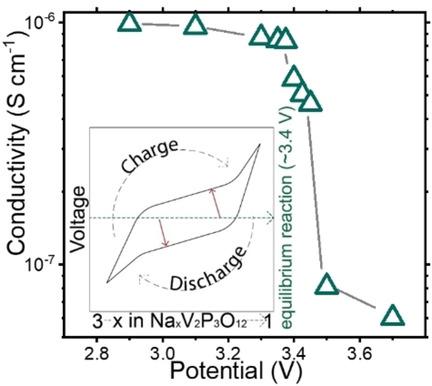当前位置:
X-MOL 学术
›
Batteries Supercaps
›
论文详情
Our official English website, www.x-mol.net, welcomes your feedback! (Note: you will need to create a separate account there.)
Ionic Conductivity of Na3V2P3O12 as a Function of Electrochemical Potential and its Impact on Battery Performance
Batteries & Supercaps ( IF 5.7 ) Pub Date : 2020-11-10 , DOI: 10.1002/batt.202000229 Tu Lan 1, 2, 3 , Qianli Ma 1 , Chih‐Long Tsai 1, 4 , Frank Tietz 1 , Olivier Guillon 1, 2, 3
Batteries & Supercaps ( IF 5.7 ) Pub Date : 2020-11-10 , DOI: 10.1002/batt.202000229 Tu Lan 1, 2, 3 , Qianli Ma 1 , Chih‐Long Tsai 1, 4 , Frank Tietz 1 , Olivier Guillon 1, 2, 3
Affiliation

|
Na3V2(PO4)3 (NVP) is a promising electrode material for sodium‐ion batteries. However, many of its electrochemical properties like ionic conductivities have never been systematically studied. In the present paper, a battery cell with controlled morphology of NVP was prepared and the electrochemical impedance spectra were measured at various voltages. The ionic conductivity of NVP was calculated in dependence on applied potentials. NVP has a total conductivity of 1×10−6 S cm−1 at 2.9 V, which decreases to 8×10−8 S cm−1 at 3.5 V. This low conductivity, especially at higher voltages, influences the performance of batteries with an NVP electrode, especially by limiting the high‐rate cycling of solid‐state batteries.
中文翻译:

Na3V2P3O12的离子电导率与电化学势的关系及其对电池性能的影响
Na 3 V 2(PO 4)3(NVP)是一种有前途的钠离子电池电极材料。然而,从未对其系统的许多电化学性质如离子电导率进行过研究。本文制备了一种具有NVP形貌可控的电池,并在不同电压下测量了电化学阻抗谱。根据所施加的电位计算出NVP的离子电导率。NVP在2.9 V时的总电导率为1×10 -6 S cm -1,下降到8×10 -8 S cm -1 在3.5 V时。这种低电导率(尤其是在较高电压下)会影响带有NVP电极的电池的性能,尤其是通过限制固态电池的高倍率循环。
更新日期:2020-11-10
中文翻译:

Na3V2P3O12的离子电导率与电化学势的关系及其对电池性能的影响
Na 3 V 2(PO 4)3(NVP)是一种有前途的钠离子电池电极材料。然而,从未对其系统的许多电化学性质如离子电导率进行过研究。本文制备了一种具有NVP形貌可控的电池,并在不同电压下测量了电化学阻抗谱。根据所施加的电位计算出NVP的离子电导率。NVP在2.9 V时的总电导率为1×10 -6 S cm -1,下降到8×10 -8 S cm -1 在3.5 V时。这种低电导率(尤其是在较高电压下)会影响带有NVP电极的电池的性能,尤其是通过限制固态电池的高倍率循环。


























 京公网安备 11010802027423号
京公网安备 11010802027423号